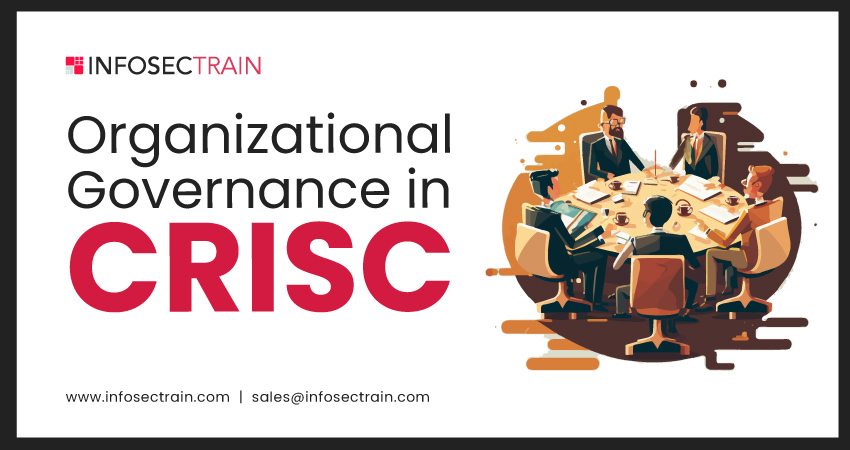Organizational Governance in CRISC
Organizational governance forms the backbone of effective risk management within an organization. From setting standards to defining roles and responsibilities, governance ensures alignment with legal, ethical, and operational requirements. In this article, we delve into the intricacies of organizational governance, its components, and its critical role in mitigating risk.

Introduction to Organizational Governance
At its core, governance serves as the glue that binds an organization’s mission, strategy, goals, and objectives together. It encompasses both internal and external elements, dictating how the organization operates within the framework of laws, regulations, and industry standards. External governance originates from regulatory bodies and industry mandates, while internal governance is shaped by organizational culture and leadership directives.
Example: In the context of the CRISC certification, organizational governance ensures that an organization’s risk management practices align with its strategic objectives and comply with relevant industry standards and regulations. For instance, CRISC professionals play a crucial role in integrating risk management into the organization’s governance framework to ensure alignment with business goals and regulatory requirements.
Organizational Strategy, Goals, and Objectives
The strategic direction of an organization, including its risk appetite and tolerance, is defined by its senior management. Aligning risk management with business objectives ensures that risks are managed in a manner conducive to achieving organizational goals. Strategic risk, emanating from high-level decisions, necessitates a balance between pursuing opportunities and safeguarding against potential threats.
Example: CRISC-certified professionals collaborate with senior management to establish risk appetite and tolerance levels that align with the organization’s strategic objectives. By identifying strategic risks and evaluating their potential impact on business goals, CRISC practitioners assist in formulating risk management strategies that enable the organization to capitalize on opportunities while mitigating threats effectively.
Organizational Structure, Roles, and Responsibilities
The organizational structure influences how risk is managed across different functional areas. While each department may have distinct responsibilities, risk management should be uniform throughout the organization. Risks accumulate at higher organizational levels, highlighting the interconnectedness of risk across various business units. Clarity in roles and responsibilities is essential for effective risk leadership and management.
Example: CRISC professionals collaborate with key stakeholders to define clear roles and responsibilities for risk management across departments. By establishing a consistent approach to risk identification, assessment, and mitigation, CRISC practitioners ensure that risk management practices are integrated into the organizational structure, promoting accountability and alignment with governance objectives.
Organizational Culture
Organizational culture shapes how risk is perceived and addressed within an organization. Leadership behavior sets the tone for acceptable risk practices, which may align with or deviate from formalized values. A strong risk culture stems from leadership ethos, governance frameworks, and adherence to legal and ethical standards.
Example: CRISC-certified professionals play a pivotal role in fostering a strong risk culture within the organization by promoting awareness of risk management principles and best practices among employees. Through training programs and communication strategies, CRISC practitioners help instill a culture of accountability and transparency, where risk management is viewed as integral to achieving organizational success.
Policies and Standards
Policies serve as the foundation of governance, providing directives for managing risk in alignment with external requirements and organizational objectives. These policies encompass risk management strategies, methodologies, and procedural guidelines. They are essential for establishing accountability and ensuring a cohesive approach to risk management across all levels of the organization.
Example: CRISC professionals contribute to the development and implementation of risk management policies and standards that comply with regulatory requirements and industry best practices. By integrating CRISC principles into policy frameworks, organizations can effectively manage risks while maintaining alignment with governance objectives and stakeholder expectations.
Business Processes
Business processes, integral to achieving organizational objectives, entail inherent risks that must be managed effectively. Formalizing processes, defining roles, and implementing metrics facilitate risk identification and mitigation. Collaboration between risk practitioners and business process owners is critical for developing key performance and risk indicators that drive continual improvement.
Example: CRISC-certified professionals collaborate with business process owners to assess and mitigate risks associated with critical business processes. By implementing risk-based approaches to process improvement and performance measurement, CRISC practitioners help organizations enhance operational resilience and adaptability while minimizing potential disruptions.
Organizational Assets
Identification and management of organizational assets are fundamental to effective risk management. Assets, ranging from physical infrastructure to intellectual property, underpin business operations and carry associated risks. Establishing asset inventories and classification frameworks enables targeted risk assessment and treatment strategies.
Example: CRISC professionals work with stakeholders to identify and prioritize organizational assets based on their criticality and vulnerability to risks. By conducting comprehensive asset assessments and implementing risk mitigation measures, CRISC practitioners help safeguard valuable assets and mitigate potential threats, thereby enhancing the organization’s overall resilience and competitiveness.
CRISC with InfosecTrain
Organizational governance forms the cornerstone of risk management, integrating legal, ethical, and operational considerations into the fabric of an organization. By aligning governance with strategic objectives, fostering a robust risk culture, and embracing effective policies and procedures, organizations can navigate complexities and safeguard against potential threats effectively.
InfosecTrain’s CRISC certification training enhances understanding of organizational governance, equipping professionals to adeptly navigate risks and align governance with strategic imperatives.
TRAINING CALENDAR of Upcoming Batches For CRISC
| Start Date | End Date | Start - End Time | Batch Type | Training Mode | Batch Status | |
|---|---|---|---|---|---|---|
| 05-Apr-2025 | 27-Apr-2025 | 19:00 - 23:00 IST | Weekend | Online | [ Open ] |







 1800-843-7890 (India)
1800-843-7890 (India)